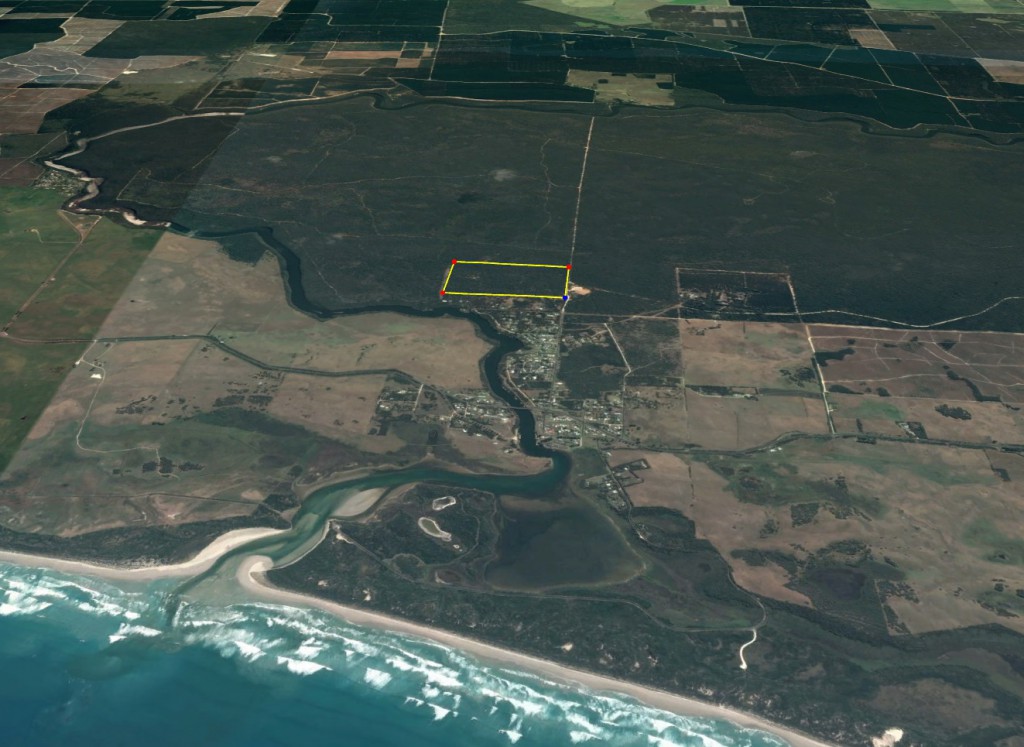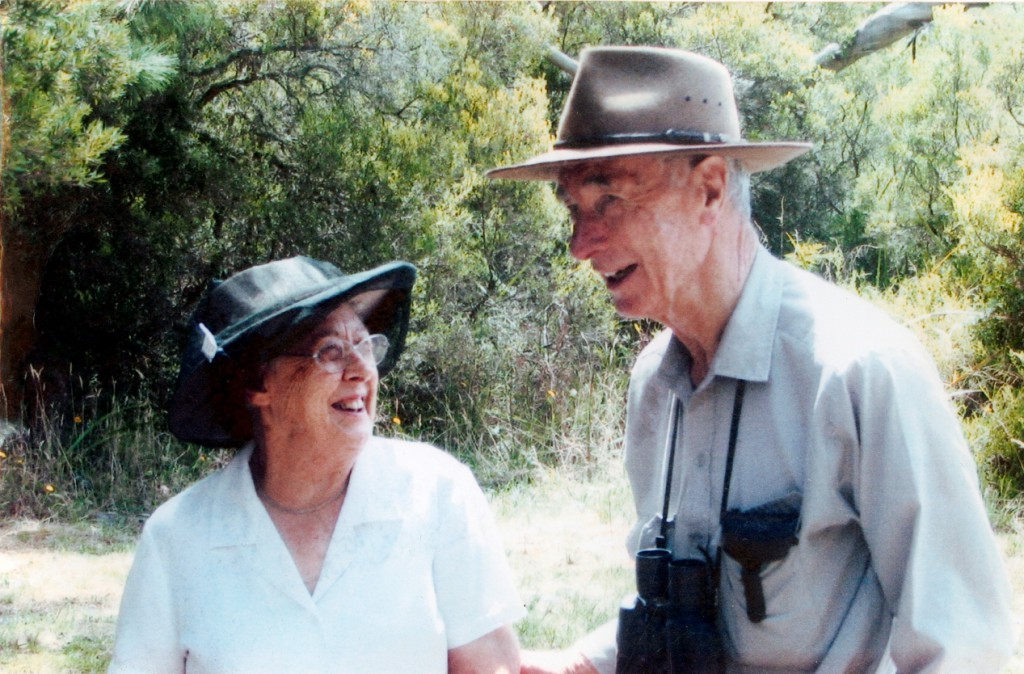
Kurrawonga (Victoria)
In an incredibly generous gesture in memory of their late parents, Bill and Kate, the Moore family decided to donate 40 hectares (100 acres) of covenanted bushland – called Kurrawonga – to Nature Glenelg Trust in early 2018. The property is situated at Nelson, on the southern edge of (and surrounded on three sides by) the Lower Glenelg National Park, in a beautiful area that provides valuable habitat for a wide range of threatened species.

Oblique image showing the location of Kurrawonga – at the doorstep of the Lower Glenelg National Park, on the edge of Nelson, Victoria.
Unlike NGT’s other reserves (Eaglehawk Waterhole and Mt Burr Swamp), which we’ve established with an emphasis on habitat restoration, Kurrawonga is an area of intact remnant bushland in excellent condition. But like our other reserves, the property is strategically located, situated adjacent to one of the region’s largest National Parks.
Some of the staff at NGT personally knew Bill and Kate dating back to the 1990s, when they were still active members of the Millicent Field Naturalists’ Society and respected elders within the group. Like many others of their era, they were extremely observant of nature and always interested to learn about their ever changing patch of bush.
The opportunity for NGT to now look after Kurrawonga, in a key part of the region where we are highly active (Long Swamp in Discovery Bay is only 10 minutes away) is an amazing privilege. We’re now beginning to think about the best ways to involve NGT supporters in the property, and also the options for integrating it into our research and education programs. Needless to say, there are lots of great possibilities.
We’d like to express our sincere gratitude to the Moore family for entrusting NGT to become the custodians of Kurrawonga – with an assurance that we’ll do our very best to honour the legacy of Bill and Kate Moore.
However, for the final word, and to explain a little more about the history of Kurrawonga, let’s hear directly from the Moore family:
“We’ve bought 100 acres of bushland near Nelson.” These were the words of our father – a man not known for making announcements, especially with a hint of excitement! And so in 1967 Kurrawonga came into our lives – although the name itself actually came some years later.
Our parents, Kate and Bill Moore, loved Kurrawonga. On most weekends for almost 50 years they drove the 35km from Mt Gambier to their retreat in brown stringy-bark and manna gum forest. It was their shared joy – a delightful contrast to busy lives in town; our father a doctor and our mother, the primary child raiser and later, a counsellor with Lifeline.
What motivated Kate and Bill to buy the property? First and foremost they shared an interest in nature. From the early 60s they had been active members of the South East Field Naturalists. Most holidays were spent camping and day trips were usually picnics in the bush. Kate’s primary motivation was to have a small property that would meet the needs of the family – a chance to enjoy together their interest in the environment, as well as a place for their five children to have fun.
In the early days we camped; Kate and Bill in the caravan, us kids in tents. Before long we had a well set-up campsite – rainwater on tap, log seats around the campfire and a long-drop toilet and bush shower. One of the first things we’d do on arrival, would be to make ‘cheese worms’ for the blue wrens. Using an old fashioned cheese grinder, we’d wind the handle and let the pieces fall into a mesh cage built to allow wrens in while keeping the larger birds out.
Kate and Bill loved the bush. They would go for at least one walk every day, binoculars around their necks, eyes peeled for interesting plants, birds and other creatures to investigate and admire. As we walked it was common to hear words such as, “If we look under that yakka we should find some spider orchids.” They got to know their patch in all its seasons, learning all the plants and compiling impressive lists of birds each visit. They became especially intimate with the resident red-necked wallaby family, watching generations come and go. First thing every morning Bill would feed the wallabies a handful of pellets, top up the bird bowl with seeds and check the water in the bird bath.
For us kids the Glenelg River, just 10 minutes’ walk away, was a major drawcard. We spent endless hours there – fishing, swimming and messing around in our canoe.
A decade or so after buying Kurrawonga, Kate and Bill had the small house built with solar water heating and wind generated electricity. It provided basic comforts, which were really appreciated as they grew older. In particular they were better able to enjoy the cool wet winters with homely food and a book by the open fire.
After retiring, Kurrawonga was even more significant in their lives. They had more time and would usually visit every week for at least two nights. Kurrawonga was also a place they shared with friends and local conservation groups. In later years, it was always wonderful to visit Mt Gambier with our own children, spending time with Kate and Bill at Kurrawonga and being inspired by their appreciation of nature. They recount how Kate and Bill would say things like, “Now, let’s see if there are koalas in this tree. We’ve seen them here several times before.”
When the time came to consider the future of Kurrawonga without Kate and Bill, our unanimous view was to donate it to a conservation group. There is no doubt Kate and Bill would be delighted and grateful to Nature Glenelg Trust for assuming custodianship of Kurrawonga. From our perspective it is heartening to feel that Kurrawonga is in worthy hands and has a fresh future.
Dick, John, Andrew, Margie and David Moore
January 2018
Stories on the NGT website about Kurrawonga
- National spotlight on the Great South West Walk – the beautiful hike that takes you past three NGT project sites! 31/07/2023
- Look who’s been captured on camera at Kurrawonga; A base for researchers and wildlife alike 27/02/2023
- Fran shares her thoughts on community and volunteering at Kurrawonga, Nelson 28/05/2021
- Clean Up Australia Day 2021! and other upcoming volunteer events 21/01/2021
- Jumping the fence – tackling invasive weeds on the Doorstep of Nelson 29/09/2020
- Fantastic news for the NGT Foundation – establishment of the Moore Family Fund 19/03/2020
- Sugar Gliders and Ghost Mushrooms – another diverse day at Kurrawonga 20/02/2020
- Wrapping up NGT involvement in Summer By The Sea 2020 23/01/2020
- The story of a Koala on a Cold Tin Roof – An eventful night at Kurrawonga 23/01/2020
- Wrapping up a colourful year, as native orchids emerge at Kurrawonga 31/10/2019


Sorry, the comment form is closed at this time.